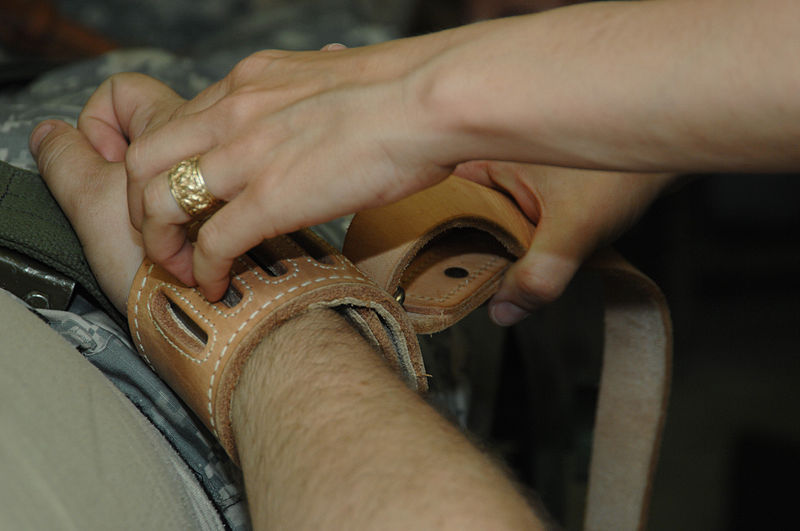A team of researchers recently investigated the experiences of those who were physically restrained in the emergency department (ED), an experience that is known to cause injuries and trauma in patients. The group conducted semi-structured, one-on-one interviews with 25 adults, and found that most patients felt coerced, that their experience was harmful, that there was a wide range of personal contexts that affected ED visits, and that there were challenges related to their restraint which had adverse effects on their well-being.
“In recalling the experience of restraint, patients described a loss of freedom and personal dignity associated with dehumanization, loss of self-determination, and even mistreatment,” wrote the researchers.
“One patient said, ‘You took all my clothes off, you had me laying on the bed strapped down with no clothes, no cover, no nothing. My privates are wide open, people just walking by, and you won’t give me any clothes or shut the curtain.’ The patient experience of restraint ranged from descriptions of being treated like an animal to being handled roughly both physically and verbally by staff, even including displays of overt antagonism and profanities.”

As many as 2.6% of all ED visits are associated with ‘agitation,’ a number that continues to rise. Treatment of ‘agitation’ is often harmful and involves physical restraint. This has led to calls for de-escalation, though that requires strong rapport and a therapeutic relationship, which is difficult to achieve in an ED context. This is made more challenging due to the high volume of patients (61%, by one study) who feel coerced by police or hospital staff, which makes establishing a therapeutic relationship all the harder. Given the dearth of research on this population, the authors sought to explore the background of the individuals themselves as well as their experiences in the ED.
To do this, the team used a grounded theory approach to interview 25 individuals who had been restrained during a visit to either a tertiary care academic referral center or a community-based teaching hospital. They used the demographic profile of patients who were restrained at the ED to recruit a sample with similar demographic backgrounds as well as with a range of period between the last time they were restrained and the date of the interview. Interview questions were developed from a literature review on patient coercion and triangulation with perceived patient perspectives from data collected from ED staff on the use of restraints.
Patients were 68% male, 72% white, and had a range of 2 weeks to 6 months from last restraint. 88% reported that their ED visit and restraint resulted from a combination of mental illness and/or substance abuse, and the majority felt their entry to the ED was coercive. Three major themes emerged from interviews: (1) harmful experiences of restraint use and care provision, (2) complex personal contexts that affected ED visits, and (3) difficulty resolving their restraint experiences that led to negative consequences on well-being.
“I will live with this broken finger, they did that to me when they held me down like that,” said one participant. “You will not break my finger again. I remember that pain and that pain didn’t go away. I was in pain for a long, long time. I think that from the bone being jammed down, it’s affecting this finger. This finger, when I bend it, it gets stuck. I have to physically push it back up because it hurts. I don’t know. If the security can get away with breaking somebody’s finger and nothing be done about that, then how can they call it a hospital?”
Patients experienced a range of emotions, including confusion, frustration, worry, feeling shunned, and a sense of isolation, which may have stemmed from the fact that 68% of them did not voluntarily choose to enter the ED. Several contextual factors preceded individuals’ admission to the ED, including substance use, mental health, or chronic medical problems that were difficult to manage and significantly affected daily life.
Social determinants were a factor related to admission and included psychosocial stressors, occupational and social backgrounds, and histories of being survivors of abuse. The treatment from ED staff and the use of restraints had a range of effects on patients, including skepticism and distrust of the medical system, the worsening of existing psychiatric conditions, or healthcare avoidance.
“The participants in this study represented the most marginalized and disadvantaged population that presents to the ED,” the researchers concluded. “They overwhelmingly described a desire for dignity, respect, compassion, therapeutic engagement, and attempts by staff to explain actions performed on them, even if the therapeutic relationship has been fractured as a result of coercion and physical restraint during agitation events.”
“Most participants did not present to the ED willingly and already felt threatened before arrival. Without psychological support from staff members during these restraint events, patients may begin a spiral of negative emotions with subsequent ED visits and instinctively escalate with short-term agitation and aggression as a protective shield based on prior experiences. Instead of providing care, we may inadvertently cause more harm to these individuals.”
These results are contrasted to a similar study done in an Australian hospital, where researchers found positive sentiments of respect, dignity, and trusting relationships with staff members. The vastly different results may be from diverse geographic and cultural conditions underpinning ED care. The authors argue that boisterous behavior from patients that resulted from mental illness or disinhibition from substance use may have caused a need for attention that the busy ED was unable to accommodate. This compounds with staff sentiments of empathy and compassion being overwhelmed by fear or frustration of verbal or physical assault.
The authors propose that a system that addresses both potential staff harm and patient safety together collectively would allow health care professionals to make conscious, balanced, and evidence-based decisions to use physical restraints only as a last resort, which would minimize negative consequences on the patients under their care.
****
Wong A.H., Ray J.M., Rosenberg A., et al. (2020). Experiences of individuals who were physically restrained in the emergency department. JAMA Network Open, 3(1):e1919381. DOI:10.1001/jamanetworkopen.2019.19381 (Link)















What means psychological impact?
https://www.theguardian.com/world/2017/jul/13/new-zealand-man-dies-tied-bed-japanese-hospital
Report comment
“The treatment from ED staff and the use of restraints had a range of effects on patients, including skepticism and distrust of the medical system, the worsening of existing psychiatric conditions, or healthcare avoidance.”
Yes, some of us don’t even want health insurance because we know that having good health insurance makes one a target of the criminals in the hospitals, like this now FBI convicted doctor.
https://patch.com/illinois/chicago/oak-brook-doctor-sentenced-role-sacred-heart-kickback-scheme
And this criminal doctor was committing these same, greed inspired, crimes against patients at other non-for-profit hospitals, like the ELCA owned Advocate Good Samaritan hospital, too.
“Instead of providing care, we may inadvertently cause more harm to these individuals.”
Absolutely, medically unnecessarily having lots of patients shipped long distances to you, “snowing” them, in the hopes of making them unable to breathe, so you may perform unneeded tracheotomies on healthy people for profit. Which is what Kuchipudi did to God knows how many patients, does result in harm, distrust of the medical system, and healthcare avoidance.
But his un-arrested psychiatric “snowing” partner in crime, Humaira Saiyed, spent years after this illegally listing me as her “outpatient” at a hospital I’d never been to. When I learned of this from a health insurance company, and told her to stop doing that. She started illegally listing me as her “outpatient” at Advocate Good Samaritan, after I’d moved out of state. Our society does need to start arresting the criminal psychiatrists, too.
The right to force neurotoxic poison people needs to be taken away from all doctors, including the psychiatrists, since it is being used to medically unnecessarily harm patients for profit. “Power tends to corrupt and absolute power corrupts absolutely.”
The absolute power, to force treat anyone for any reason (in my case it was a sleep walking/talking issue, not a “chronic airway obstruction” or any of the so called “mental illnesses,” plus the desire of that psychiatrist to cover up prior malpractice, as well as the medical evidence of the abuse of my child for the ELCA religion) has corrupted psychiatry absolutely.
We need a return to the rule of law, a return to the understanding that separation of powers is wise, which can’t happen until the right to force treat people is taken away from the criminal and scientific fraud based psychiatrists.
And, given the reality that the primary actual societal function of the psychiatrists and psychologists, historically and today, is covering up child abuse, which is illegal. Most psychiatrists and psychologists likely are child abuse covering up criminals.
https://www.indybay.org/newsitems/2019/01/23/18820633.php?fbclid=IwAR2-cgZPcEvbz7yFqMuUwneIuaqGleGiOzackY4N2sPeVXolwmEga5iKxdo
https://www.madinamerica.com/2016/04/heal-for-life/
https://www.psychologytoday.com/us/blog/your-child-does-not-have-bipolar-disorder/201402/dsm-5-and-child-neglect-and-abuse-1
And it is absolutely appalling that the psychiatrists are murdering 8 million people a year, every year, via their scientific fraud based DSM disorders, and with their psychiatric neurotoxins. That’s more than the 6 million Jews that the Nazi psychiatrists murdered … every year.
https://www.nimh.nih.gov/about/directors/thomas-insel/blog/2015/mortality-and-mental-disorders.shtml
https://www.nimh.nih.gov/about/directors/thomas-insel/blog/2013/transforming-diagnosis.shtml
That would be approximately 400,000,000 psychiatric murders in the past 50 years. It’s time to end the modern day, ongoing, American and all Western civilization, psychiatric holocaust!
Report comment
How to not be dehumanizing when they don’t see the humanity in their ‘patients’?
Psychiatrists and mental hospital staff definitely should learn Empathy as a discipline in medical schools.
Report comment
One cannot learn empathy in a course. Just as one can’t learn to be nasty to humans in a course.
They do in fact have courses on “empathy”, what it looks like, but it is a short burst to validate that their other courses are good for the patient.
Indeed, the blurbs on empathy are taught alongside of manipulation. So most docs always have the defensive in their heads (which of course were there before the decision to become a shrink) They defend against the possibility that their client is busy manipulating them, and the other thought lingering around in their serotonin, neonephrine, dopamine, receptors and synapses and neurons…short for paranoia, is the medical malpractice possibility.
One has to be concerned about this first and foremost when doling out shit theories and meds.
Although I’m not sure why, because someone gave them licence to use humans as guinea pigs.
I still feel sorry for all the damage done to animals, just to continue to damage the human animal.
The most useless occupation for a child to aspire to. Sitting in a chair, on their ass, branding people.
They feel disrespected 🙂 Yes, they felt that way early on.
Report comment
“These results are contrasted to a similar study done in an Australian hospital, where researchers found positive sentiments of respect, dignity, and trusting relationships with staff members.”
https://www.watoday.com.au/national/western-australia/the-true-extent-of-assaults-on-nurses-in-the-wa-health-system-20190213-p50xjq.html
https://www.perthnow.com.au/news/wa/graylands-patient-died-after-injection-coronial-inquest-told-ng-c54018a0b8206469536caf0800619c01
Is that second article written by THE Phil Hickey?
Ah yes but Australian Hospitals have the right to “edit” any documents to provide false and misleading information to anyone they wish. I have that from good authority, the Minister for Mental Health no less. Cover ups to misrepresent data here is common place. And I note they didn’t ask the people who have had their necks broken and died as a result of restraints here in Australia. It’s also the case that we do not have any “National Standard” as to what constitutes a “chemical restraint” here either. Consider that fact carefully. A little bit of dribble therapy never hurt anyone did it? Well, maybe just a few.
“Footage has emerged of a mentally ill woman stumbling around a NSW hospital, covered in faeces and falling over at least 25 times before she died of a brain injury the next day.
The horrific video from Lismore Adult Mental Health Inpatient Unit, situated at Lismore Base Hospital, was released on Friday following a coronial inquest”
Respect, dignity and trusting relationships? I can’t begin to imagine what it must be like elsewhere if we have such respect dignity and trusting relationships.
Report comment
Woohoo, we need a study?
Perhaps the best way to do a study is for researchers to do crystal meth, then their friends can call the cops, the cops can slam or taser the user, bring them to ER, there the researchers can deal with perverts who DO get an adrenaline rush from the assaults.
I would like scans done on the assaulters, during these disturbed encounters. I would like to know if pleasure zones light up?
We need to know the truth about the treaters. We need to know, which parts get stimulated and why. If pleasure is derived, then we need to see that as a danger.
Now most NORMAL people would shy away from holding people down. Most normal people would not reach for brain frying drugs to deal with an upset person.
It is nothing more than anger diverted to others.
Hopefully most learn to never allow it to happen again.
Report comment
Once my medical files stated I had a mental illness, I was never treated the same. I admit, I struggled with eating and meeting my body’s needs(child sexual abuse not being taken seriously can teach one that they don’t deserve to have their needs met). But when I had gotten myself in a medically fragile state requiring emergency services to correct a life threatening electrolyte imbalance and presented myself to the ER, I was put in 4 point restraints since the eating disorder was “self harm”, left with the curtains wide open for all patients and their families to see and refused a phone call to my psychologist who would tell them I was safe, as I took myself there. This was done at 2 other hospitals in a 2year span, all because instead of seeing a hurting human who was scared to die and trying to get help, they saw a label, SMI, and treated me accordingly. Their abuse has hindered my life in so many ways. How do you trust humans when those from childhood up to the “helpers” as an adult all proved that everyone is a potential threat? That’s not paranoia, that’s reality based on life experiences for me….
Report comment
In other news, hitting people on the head is associated with bleeding and broken skulls. Though not everyone suffers from broken skull. Perhaps we should study “weak skull disorders” to figure out why certain people’s heads are too weak to withstand being hit by a big hunk of wood?
Report comment